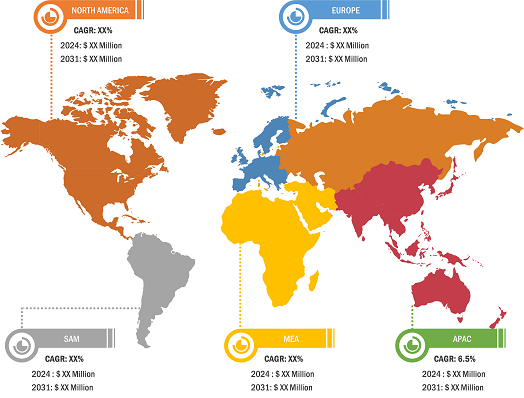The Rapid Development of IoT (Internet of Things) and Smart-Domain Applications Boost Omni Directional Antenna Market Growth
According to our latest study titled “Omni Directional Antenna Market Forecast to 2031 – Global and Regional Share, Trend, and Growth Opportunity Analysis – by Product Type, Technology, and Industry,” the market was valued at US$ 519.76 million in 2024 and is projected to reach US$ 713.21 million by 2031; it is estimated to register a CAGR of 4.7% during 2025–2031. The report includes growth prospects in light of current Omni Directional Antenna market trends and factors influencing market growth.
The rapid development of IoT (Internet of Things) and smart-domain applications is a major contributor to growth in the omnidirectional antenna market. As commercial and industrial entities adopt more connected devices to monitor, automate, or exchange real-time data, widespread, reliable wireless coverage will become increasingly important. Omnidirectional antennas allow for 360° signal reception and transmission, which helps to provide effective communication in environments where fixed alignment is not realistic, such as in the application of smart cities, agriculture, logistics, and industrial automation. Devices and applications such as smart meters, environmental sensors, connected vehicles, or automated factories require reliable network availability, often over large or irregular terrains. In particular, agriculture can leverage omnidirectional antennas when deploying IoT-based solutions for irrigation, crop monitoring, or drone communication for distribution. Similarly, smart city infrastructure requires a flexible and scalable wireless network for services such as traffic systems, surveillance, and public Wi-Fi. An omnidirectional antenna can provide a flexible wireless option for those applications. The growth in IoT adoption and development is expected to amplify the demand for omnidirectional antennas worldwide, and thus drive the omni directional antenna market size.
Omni Directional Antenna Market – by Region, 2024 and 2031
Omni Directional Antenna Market Size and Forecast (2021 - 2031), Global and Regional Share, Trend, and Growth Opportunity Analysis Report Coverage:By Product Type (Monopole Antenna, Dipole Antenna, Helical Antenna, and Others), Technology (5G, 4G/LTE, Wi-Fi, Bluetooth, GPS/GNSS, and Others), and Industry (Telecommunications, Consumer Electronics, Mining, Aerospace and Defense, Industrial, Automotive and Transportation, and Others
Omni Directional Antenna Market Growth & 2031 Forecast
Download Free Sample
Source: The Insight Partners Analysis
The omni directional antenna market analysis has been carried out by considering the following segments: product type, technology, and industry. Based on product type, the market is divided into monopole antenna, dipole antenna, helical antenna, and others. In terms of technology, the Omni Directional Antennas’ market is classified into 5G, 4G/LTE, Wi-Fi, bluetooth, GPS/GNSS, and others. By industry, the market is segmented into telecommunications, consumer electronics, mining, aerospace and defense, industrial, automotive and transportation, and others. The telecommunications segment held the largest omni directional antenna market share in 2024.
The geographic scope of the omni directional antenna market report is segmented into North America (the US, Canada, and Mexico), Europe (Russia, the UK, Germany, France, Italy, and the Rest of Europe), Asia Pacific (South Korea, China, India, Japan, Australia, and the Rest of Asia Pacific), Middle East & Africa (the UAE, Saudi Arabia, South Africa, and the Rest of Middle East & Africa), and South & Central America (Brazil, Argentina, and the Rest of South & Central America). Asia Pacific accounted for the largest omni directional antenna market share in 2024. With the robust digital transformation and major upgrades to telecommunication infrastructure in APAC, the omni-directional antenna market is the largest and quickest segment of growth. Governments in countries such as China, India, Japan, and South Korea invest heavily in building 5G networks, with smartphone adoption rates skyrocketing and spectrum strategies encompassing 3G, 4G, and 5G. The investment in infrastructure and expansion of capabilities in telecommunication networks needs state-of-the-art antenna technology. Omni-directional antennas provide connectivity in 360 degrees, evenly distributed throughout dense and variable environments as the telecom ecosystem expands coverage and capacity with strategic deployment of 4G and 5G capabilities.
Panorama Antennas Ltd.; Sinclair Technologies Inc; Airgain, Inc.; Cisco Systems Inc; Ezurio; Huawei Technologies Co Ltd; PCTEL Inc.; 2J Antennas S.R.O.; Parsec Technologies; Quectel Wireless Solutions Co Ltd; Johanson Technology Incorporated; TE Connectivity Ltd; Pulse Electronics; Taoglas; Hubbell Inc; Mobile Mark, Inc; and Galtronics USA, Inc. are among the key players profiled in the omni directional antenna market report.
Contact Us
Phone: +1-646-491-9876
Email Id: sales@theinsightpartners.com